Your Cart is Empty
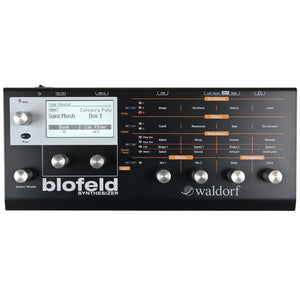
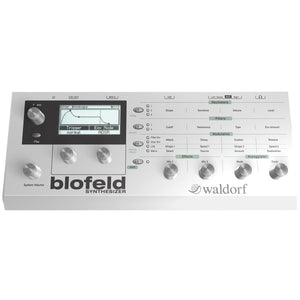
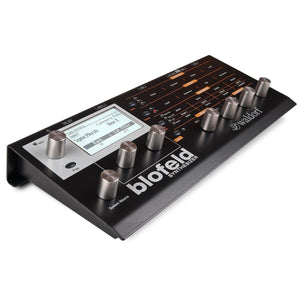
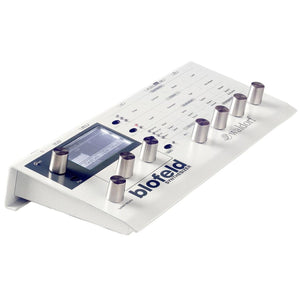
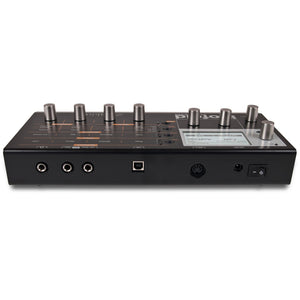
$999.00$1,176.46
WAL-BLOFELDDT-BK
Waldorf Blofeld Desktop Digital Synthesizer
Waldorf are no newcomer to synthesis and the Blofeld carries on their legend of making delicate, textural synth sounds. Waldorf is back in the game. With the Blofeld. This synthesizer offers all the unique qualities that made Waldorf a truly legendary brand. The engine inside the heavy duty, full metal chassis of the Blofeld delivers the same fat and rich sound that so many Waldorf users worldwide love when they play their Pulse, Q, Q+, Micro Q, Microwave, Microwave II/XT, or even the flagship Wave.
Type: Desktop Synthesizers
-
-
Waldorf Blofeld Desktop PRODUCT FEATURES:
Yes, you've heard it right. The Blofeld is not only capable of producing these warm, organic analog sounds known from the Q synthesizer line, it also sports a wavetable engine like its predecessors with "Wave" in their names.
This unique synthesis system is based upon the revolutionary PPG Wave synthesizers of the early 80s. So when you listen to the Blofeld for the first time, you will instantly recognize those edgy, hard-hitting and bell-like timbres that have been an integral part of so many world hits from the PPG era on, and become increasingly popular once more.
Oscillators
Each of the three oscillators offers authentic circuit-models of analog waveforms: Pulse with variable pulse-width, sawtooth, triangle and, as found in relatively few analog synthesizers these days, sine wave.
Furthermore, oscillators 1 and 2 feature the two wavetables that were introduced by the Waldorf Q and appeared shortly thereafter in the Micro Q series.
Not only that, the Blofeld includes all ROM Wavetables from the mighty flagship Waldorf Wave as well as Microwave II/XT. Plus, lo and behold, the desperately requested "Upper Wavetable" from the good old PPG Wave! But, for the first time in the history of Waldorf and PPG, each of these two oscillators can have its own wavetable.
What's more, you have control over the brilliance of these wavetables, which is especially important for waves with lots of harmonics in the bass end. You decide if you prefer pure and perfect harmonics or the same edgy timbre you know and love from the earlier Waldorf and PPG synthesizers.
Brilliance also affects the sawtooth and pulse oscillator models. From warm and soft (for those typical L.A. string pads) to the hard shapes you need for punchy and biting bass sounds. But note, Brilliance is not a simple filter applied after the oscillators, the model itself is modified.
Each of the three oscillators can be frequency-modulated by any of the other oscillators, the noise generator or one of the LFOs. With low FM amounts, you can add a little dirt to the oscillator sound, with higher amounts you get typical FM effects.
On top of all that, oscillator 2 can be hard-synced to oscillator 3.
Ring Modulation and Noise Generator
Oscillators 1 and 2 can be ring-modulated to create bell-like or metallic sounds, eerie sound effects as well as pumping basses and leads.
The noise generator delivers white noise that can be filtered low or high pass, depending on the Noise Colour setting.
The three oscillators, the ring modulator and the noise generator can be freely mixed into filter 1 and filter 2. This allows fine control over the harmonic content of each of the tone generators.
Filters
The Blofeld has two multimode filters per voice that can be routed in series or in parallel. Each Filter has its own Pan parameter for easy creation of stereo sounds.
The selection of filter types includes low pass, band pass, high pass and notch (band reject), each with 12dB/oct or 24dB/oct slope. The filter models are based on several famous Waldorf filter algorithms found in all our products. They offer resonance up to self-oscillation as well as frequency modulation (filter FM).
Furthermore, the Blofeld features the same comb filter types (with positive and negative feedback) that we first introduced in the Waldorf Q. These can be used to thicken bass and pad sounds or to create percussive, string or flute sounds reminiscent of physical modelling.
Overdrive, Saturation, Distortion, Shaping
You name it. The Blofeld offers a freely controllable "Drive" behind each filter with more than a dozen curves. These include such standards as the drive from the Q and Micro Q, low/medium/hard saturation, tube saturation, two types of electric pickups, a rectifier, digital overflow as well as esoteric stuff such as "binary distortion", a sinusoidal waveshaper and even a distortion controlled by oscillator 1. And because the Blofeld has two filters that can be routed in series, you can control the timbre of the drive output of Filter 1 by dampening or emphasizing certain frequencies with filter 2.
Effects
The Blofeld has two effect slots with various types. In Multimode, the first effect slot is available per Part, while the second one is used for all 16 Parts (i.e. global) with controllable mix levels. Part 1 determines the settings of the second effect.
The first effect slot offers such modulation effects as chorus, flanger as well as a combined type called "Triple FX". The latter gives you several effects at once, but with a reduced parameter set.
The second effect slot offers all the same types as the first, but with the addition of delay, clocked delay and reverb.
Envelopes
Four envelopes with different types and trigger modes affect any sound parameters you choose.
Each envelope can be either polyphonic or single trigger. This is especially interesting with the monophonic voice allocation, as the filter envelope can be set to be triggered only by the first note(s) while the Amp Envelope is triggered anew (i.e. on each note). Think "organ percussion register", for instance.
The Envelope types include the standard ADSR as well as an enhanced ADSR-variant (with controllable attack level and two decay and sustain stages), two different loop envelopes and a "one shot" Envelope.
The Loop types can be used to act as additional LFOs, while the One Shot is perfectly suited for percussion sounds (which typically ignore the note release).
LFOs
Each of the three LFOs offers sine, triangle, square and sawtooth waveforms, plus sample & hold and random.
LFOs can be synchronized to MIDI clock, they can be polyphonic or monophonic, reset on key trigger to a freely definable phase, and the speed can be scaled by MIDI note (key follow). There are separate delay and fade in/out parameters for e.g. delayed vibrato (positive Fade values) or a burst of vibrato at the start of each note (negative Fade values).
One important feature of the Blofeld LFOs is that higher rates reach well into the audio frequency range, thus making them useful extra FM sources. There are two basic modes: either linear FM as seen in classic digital synths, or logarithmic FM, which is primarily the domain of analog modular systems.
Modulation Matrix
Here's where the real Waldorf power lies. Each and every instrument designed and built by Waldorf lets you connect dozens of modulation sources to all the important sound generation parameters.
Individual or multiple oscillator pitches, their pulsewidths and waveforms, their levels and filter-balances, FM modulation amounts, individual filter cutoff and resonance, filter FM amounts and stereo panning, or just the good old sound output level - everything can be controlled from internal modulation sources or from a variety of MIDI messages such as velocity, keytrack, continuous controllers (including wheels, breath and foot controllers) etc.
You can of course "modulate the modulators" i.e. control LFO speeds and individual envelope rates and levels. But in Blofeld you can even specify that these sources modulate themselves - recursive modulation! For instance, modulating an envelope rate by the same envelope (or another one) can alter the shape of the slope dramatically from the standard exponential curve to linear to inverse exponential.
And how many slots do you get in the mod matrix? Two? Three? Four? No, we're talking big here. You get 16 freely definable slots plus all the pre-routed modulation destinations such as pitch, Osc 1, 2 and 3 frequency and PWM (pulse width modulation), filter 1 and 2 cutoff, panorama and amp level modulation. And let's not forget that the filter envelope is already routed to filter 1 and 2 cutoff, and the amp envelope is routed to the amp level. Makes a total of 33 simultaneous connections if we counted correctly.
Modifiers
What if you want something really really crazy, like controlling a pitch vibrato done by LFO 3 with the modulation wheel. Although there are a few such composite modulation sources such as "LFO1*MW" (LFO 1 controlled by Modulation Wheel) and "LFO2*Press" (LFO 2 controlled by monophonic Aftertouch), there's nobody doing the "LFO3*MW" thing for you.
But, don't worry, that's where the Modifiers come into play. In seconds you can set up a new modifier, with the two sources set to LFO 3 and modulation wheel, and the "operation" set to "*" (multiply). You can use such custom-made modulation sources in any of the modulation slots described above.
Okay, maybe you are more the regular musician who simply wants to perform a binary OR between two modulation sources? Okay, go for it! This operation is just one of several at your service.
Arpeggiator
Okay, Blofeld's arpeggiator could very well become the biggest chapter of this page but let's try to keep it short...
It features variable clock divisions from 1/64 triplets to more than 1000 bars, with variable swing/shuffle, a range of up to 10 octaves. Up, down and alternate figures, selectable play order from low to high note, low to high velocity, as played or reversed, variable note length, different velocity modes. And Hold or One-Shot, if you like.
But more importantly, it has the most powerful Pattern Editor we have ever seen.
You can set each Step to either play the note it would do so anyway, to pause, to play the previous note again, play the first or the last note, play those together, play a chord consisting of all held notes or a randomly selected note.
Then you can adjust the Accent of each step (including silence), activate or deactivate Glide for each step, set the timing to play a step ahead or behind its nominal time, and finely adjust the note length between short staccato and full legato.
No wonder this arpeggiator had great reviews when it first appeared in the Waldorf Q. It will take you straight to arpeggiator-heaven, as has already happened to thousands of Waldorf customers. Dig it!
Sound
Now, how does all that sound? You probably know that Waldorf synthesizers are well loved for their sound character, and the Blofeld is certainly no exception. But who are we to tell you? Better listen to the Waldorf Blofeld demos, visit your dealer or just believe us: it sounds great. Now go and get one! -
Waldorf Blofeld Desktop TECHNICAL SPECIFICATIONS:
Most important features:
Unbeatable price tag
sturdy Metal Enclosure
7 endless stainless steel Dials
Graphic Display 128 x 64 pixels, b/w, white background LED
more than 1000 Sounds
3 Oscillators per voice
Frequency Modulation between the Oscillators
All Q Oscillator Models
All Microwave II/XT/XTk Wavetables
2 independent Multi Mode Filters per voice
Filter FM
2 Drive stages per voice with selectable Drive Curves
3 fast LFOs per voice
4 fast Envelopes per voice
powerful Arpeggiator
freely programmable Arpeggiator Pattern with up to 16 Steps per Sound
General Features:
up to 25 Voices
16 part multi timbral
more than 1000 Sounds
sturdy Metal Enclosure
7 endless stainless steel Dials
5 Buttons
Graphic Display 128 x 64 pixels, b/w, white background LED
MIDI LED
Volume Control
Power Switch
Stereo Output
Headphone Output
MIDI In
USB Connector for MIDI In / Out
uses standard USB MIDI Driver provided by host computer OS Windows ME minimum, Windows XP or newer recommended Mac OS X 10.2 minimum, Mac OS X 10.3 or newer recommended
External Power Supply
Per Voice
3 Oscillators
Virtual Analog Models:
Pulse with Pulse Width Modulation and adjustable Brilliance
Sawtooth with adjustable Brilliance
Triangle
Sine
Wavetables:
Q Alt 1 and Alt 2 Wavetable with adjustable Brilliance
All Wavetables from Microwave II/XT/XTk Series with adjustable Brilliance
Separate Wavetable selectable for Oscillator 1 and 2
Frequency Modulation between the Oscillators
Oscillator Synchronization
Ring Modulator for Osc 1 / 2
Noise Generator with Noise Colour
2 independent Multi Mode Filters
Filter FM
Resonance up to Self-Oscillation
Low Pass 24 dB / 12 dB
Band Pass 24 dB / 12 dB
High Pass 24 dB / 12 dB
Notch 24 dB / 12 dB
Comb Filter with positive / negative Feedback
PPG Low Pass Filter
2 Drive stages per voice with adjustable Drive Gain and selectable Curves
Clip
Hard
Medium
Soft
Sine Shaper
Modulation Matrix with 16 Slots, freely programmable
Modulation Speed far into Audio Range
Modulation Sources include all internal Modulation Sources plus various MIDI messages
Modulation Destinations for almost all continuous sound parameters various pre-routed Modulation Destinations with selectable Sources
Pitch Modulation
Oscillator 1 / 2 / 3 Frequency Modulation
Oscillator 1 / 2 / 3 Pulse Width Modulation
Filter 1 / 2 Cutoff Modulation
Filter 1 / 2 Frequency Modulation
Pan 1 / 2 Modulation
Amp Modulation
4 Modifiers for transforming Modulation Sources with various Algorithms
3 fast LFOs
syncable to MIDI Clock
Note Retrigger with adjustable Start Phase
monophonic LFO
Keytrack
4 fast Envelopes with selectable types
Single Trigger / Retrigger per Envelope
ADSR
ADS1DS2R (2 Decay/Sustain stages plus adjustable Attack Level)
One Shot
Loop S1S2 (Loop between Sustain 1 and 2)
Loop All (Loop over all stages)
Poly, Mono, Dual or Unisono Mode with selectable Voice Count
Per Part
powerful Arpeggiator
Hold and One Shot modes
syncable to MIDI Clock
Direction Up, Down, Alternate
Range up to 10 Octaves
various methods to modify Note Sort Order
freely programmable Arpeggiator Pattern with up to 16 Steps per Sound.
programmable per Step:
Accent
Timing
Length
Glide on/off
Pause
Chord
Previous note
Random not from Note List
first and/or last note from Note List
1 Effect slot per part
1 Effect slot globally for all parts
Effect types:
Chorus
Flanger
Phaser
Overdrive
Triple FX (S&H, Ring Modulation, Chorus)
Delay (only available on global Effect slot)
Clocked Delay (only available on global Effect slot)
Reverb (only available on global Effect slot)





